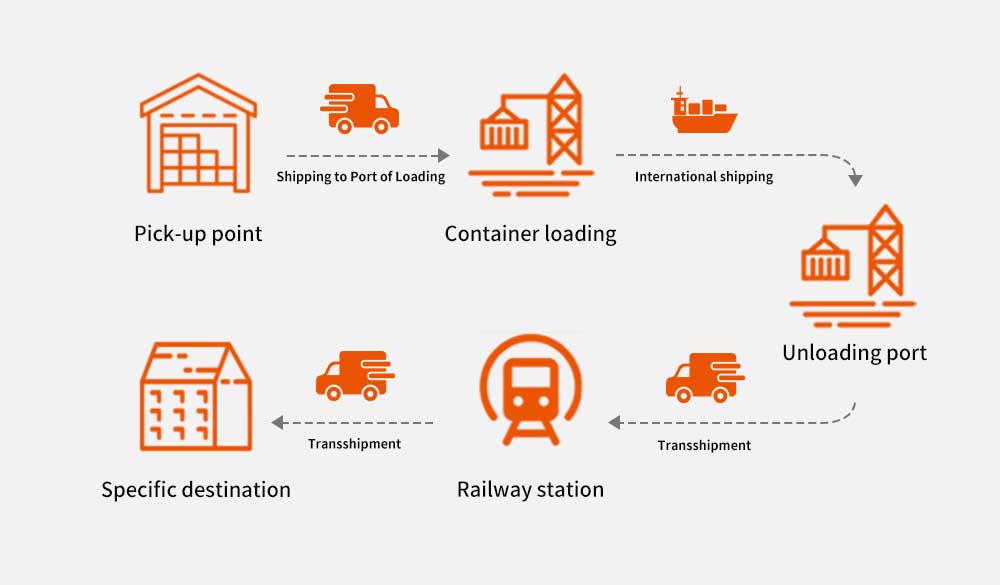Multimodal transport is one of the cost-effective logistics solutions for international trade. Today, let’s delve into its definition, advantages, and how it works in cargo shipping.
What is multimodal transport?
Multimodal transport, often referred to as combined transport, is a logistics strategy that involves the seamless movement of goods using multiple modes of transportation under a single contract.
Types of multimodal transport
This strategy integrates various transportation modes, such as air, sea, road, and rail, to ensure the cost-effective and timely delivery of goods from the origin to the destination.
An illustrative instance of multimodal transport is the Rail-Truck or overland approach. Carriers like Airsupply support such services, for example, aligning with China’s Belt-and-Road initiative for goods to move from Asia to Europe.
The beauty of multimodal transport lies in its flexibility and adaptability. Businesses can choose from various types based on their specific logistical needs, budget constraints, and urgency requirements.
How does multimodal transport work?
Imagine you’re a business owner in China, and you need to ship a batch of electronics to a retailer in Germany. And you want to use multimodal transport, combining sea, rail, and truck to optimize the shipping process, the following is the detailed process:

Origin and first leg: You start by arranging for the electronics to be picked up from your factory in Shenzhen, China. A trucking company transports the goods to a specific seaport.
Ocean freight: Then, your carrier will load the cargo on a ship bound for a European port, such as the port of Hamburg, Germany.
Transshipment: Upon arrival at the port of Hamburg, the container is unloaded from the ship and transferred to a train terminal within the port area.
Rail freight: Through train shipping, your cargo will arrive at the destination city. The train travels through multiple countries and is part of logistics networks connecting major European cities.
Final leg: After your shipment has arrived at a rail terminal in the destination city, a trucking company takes over to transport the electronics to the retailer’s warehouse in Germany.
By seamlessly transitioning between different modes of transportation—trucking, ocean freight, rail, and local delivery—the shipment arrives at its destination in Germany. Moreover, this multimodal transport can reduce transit times by up to 30%, ensuring that goods reach the destination market faster.
To free your hand, you can partner with Airsupply, a reliable freight forwarder who can arrange the cargo movement on your behalf. We offer seamless multimodal shipping at competitive prices, promising fast and on-time delivery.
What are the benefits and challenges?
As mentioned above, multimodal transport often offers time and cost savings than using individual modes of transportation. It optimizes routes and allows flexibility in choosing the best methods according to cost, time, and cargo type.
By using more eco-friendly modes of transportation, such as trains and ships, multimodal transport contributes to reduced carbon emissions.
However, multimodal transport involves coordination between multiple carriers, terminals, and logistics providers. Any communication breakdown can lead to delays or errors. In addition, different modes and regions often have their own regulations and requirements, making compliance challenging.
Is intermodal and multimodal transport the same?
While both terms are often used interchangeably, there’s a subtle difference. Intermodal transport involves the movement of cargo using various modes, but each leg operates under separate contracts. Multimodal transport operates under a single contract with a single point of responsibility.
Below are more detailed differences between intermodal and multimodal transport:
– In intermodal transport, the cargo remains in the same container across modes. In multimodal transport, containers may change during transfers. It can be more flexible by using different containers as needed.
– Multimodal transportation typically uses a unified set of documents for all goods, while intermodal requires multiple shipping documents for each participant involved in the transportation process.
– Both require coordination. However, in intermodal transport, different carriers handle various legs of the transportation journey. The responsibility is divided among all participants, making assigning blame in case of damage challenging. If you hire a freight forwarder to handle intermodal shipping, he only arranges the coordination between each carrier for you. In multimodal transport, a single responsible entity manages the entire journey.
When to use multimodal logistics?
Long-distance and large-scale shipments: If your goods need to travel a considerable distance, especially across different countries or continents, multimodal transport system can provide a seamless solution.
Complex routes: When your shipment’s journey involves multiple stages, such as trucking to a rail terminal and then transferring to a ship, using a single mode of transport may not be feasible.
Optimal resource utilization: For businesses with fluctuating shipping volumes, multimodal transport offers resource optimization. You can adjust the capacity and mode of transportation based on the specific needs of each shipment.
How does Airsupply assist your cargo shipping?
Airsupply can offer you a wide range of options from sea, rail, and road to air freight, leveraging its extensive network of partners and carriers. They will customize multimodal logistics solutions tailored to your shipment needs, ensuring compliance with regulations.
On the other hand, multimodal transport involves various documents for each shipping mode. Airsupply experts assist you in preparing all the necessary paperwork to get smooth customs clearance. Furthermore, they provide 24/7 real-time tracking of your shipment at each stage of its journey, allowing you to monitor progress and anticipate any delays.




